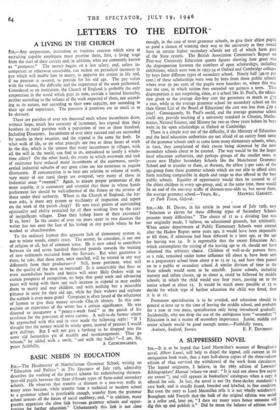Sta,—Mr. H. Davies, in his article in your issue of
July 12th, says " Selection at eleven for these differing types of Secondary Schools presents many difficulties." The choice of i r as a dividing line was not originally made, I believe, on educational grounds, but arbitrarily. When senior departments of Public Elementary Schools were created after the Hadow Report some years ago, it would have been impossible to fill them, if admission had been deferred to a later age, as the age for leaving was 14. It is regrettable that the recent Education Act, which contemplates the raising of the leaving age to 16, should not have reformed this arbitrary =choice. Children of well-to-do parents have, as a rule, remained under home influence till about 9, have beeri sent to a preparatory school from about 9 to 13 or 14, and have then passed on to a public or secondary school. A similar division of time in the State schools would seem to be sensible. Junior schools, including nursery and infant classes, up to about 9, could be followed by middle schools, in which the child would stay four years, passing on to the senior school at about 13. It would be much more possible at 13 to decide for which type of further education the child was fitted, than it is at rt.
Premature specialisation is to be avoided, and education should be general at.least up to the time of leaving the middle school, and probably for a year or two more, specialisation only being introduced gradually. Incidentally, why not drop the use of the ambiguous term " secondary "? Education is. not a matter et secondary importance. Junior, middle and senior schools would be good enough names.—Faithfully yours,


























 Previous page
Previous page